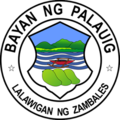Palauig | |
|---|---|
| Municipality of Palauig | |
 Downtown area | |
 Map of Zambales with Palauig highlighted | |
 Interactive map of Palauig | |
Location within the Philippines | |
| Coordinates: 15°26′01″N119°54′30″E / 15.4336°N 119.9083°E | |
| Country | Philippines |
| Region | Central Luzon |
| Province | Zambales |
| District | 2nd district |
| Founded | 1870 |
| Reestablished | January 1, 1910 [1] |
| Barangays | 19 (see Barangays) |
| Government | |
| • Type | Sangguniang Bayan |
| • Mayor | Christian Daniel H. Aceron |
| • Vice Mayor | Billy M. Aceron |
| • Representative | Doris 'Nanay Bing' Maniquiz |
| • Municipal Council | Members |
| • Electorate | 28,607 voters (2025) |
| Area | |
• Total | 310.00 km2 (119.69 sq mi) |
| Elevation | 9.0 m (29.5 ft) |
| Highest elevation | 2,037 m (6,683 ft) |
| Lowest elevation | 0 m (0 ft) |
| Population (2024 census) [4] | |
• Total | 43,250 |
| • Density | 139.5/km2 (361.3/sq mi) |
| • Households | 9,612 |
| Economy | |
| • Income class | 3rd municipal income class |
| • Poverty incidence | 28.92 |
| • Revenue | ₱ 285.1 million (2022) |
| • Assets | ₱ 709.2 million (2022) |
| • Expenditure | ₱ 183.8 million (2022) |
| • Liabilities | ₱ 254.6 million (2022) |
| Service provider | |
| • Electricity | Zambales 1 Electric Cooperative (ZAMECO 1) |
| Time zone | UTC+8 (PST) |
| ZIP code | 2210 |
| PSGC | |
| IDD : area code | +63 (0)47 |
| Native languages | Sambal Ilocano Tagalog |
Palauig, officially the Municipality of Palauig (Sambal : Babali nin Palauig; Ilocano : Ili ti Palauig; Filipino : Bayan ng Palauig), is a municipality in the province of Zambales, Philippines. According to the 2024 census, it has a population of 43,250 people. [6]
Contents
- Geography
- Barangays
- Climate
- Demographics
- Language
- Economy
- Government
- Local government
- Tourism
- Special Administrative Zone
- Education
- Primary and elementary schools
- Secondary schools
- Gallery
- References
- External links
The municipality of Palauig is the nearest mainland to the Philippine-claimed EEZ Panatag Shoal, or Scarborough Shoal, which the country places under Masinloc to the town’s north.







